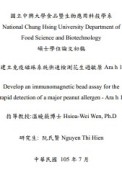|
Tác giả: Nguyen Thi Hien; 溫 曉 薇 博士 (người hướng dẫn khoa học). |
|
National Chung Hsing University. Năm: 2016. |
|
Mô tả: 74Tr, kích thước: 30cm. Số định danh: 633.36893/ H302. Vị trí: Phòng đọc. |
|
Tóm tắt: Peanut plays an important role in food allergy because only small amounts of peanut proteins can induce severe allergic reactions, and the Ara h 1 is a major allergen. There is no effective treatment for food allergy and the only way is to avoid specific allergens in food. Therefore, a method to detect peanut allergen is necessary. The magnetic beads are an efficient tool to enhance sensitivity by capturing and isolating target molecules from samples. Firstly, crude peanut proteins were obtained from defatted peanut and then precipitated at higher concentrations of ammonium sulfate (70-100%). Subsequently, Ara h 1 was purified in a HiTrap Q HP with a linear salt gradient (0 - 1 M NaCl). Furthermore, three antibodies against Ara h 1 were produced, by immunizing rabbits with 2 immune-dominant epitopes of Ara h 1 and pure Ara h 1 whole protein. Epitope-L (KSSPYQKKTENPCAQR) was from the leader peptide region of Ara h 1, while Epitope-M (SNREVRRYTARLKEG) was from the core region of Ara h 1. Both anti-Ara h 1 antibodies and anti-Epitope-M antibodies have no cross-reactivity with other peanut proteins or proteins from 10 nuts and seeds; while anti-Epitope-L antibodies displayed the reactivity with proteins from almond, macadamia, cashew, flax, and rapeseed. Therefore, anti-Ara h 1 antibody was conjugated to the surface of immunomagnetic beads (IMBs) to capture the Ara h 1 in samples, and anti-Epitope-M Ab was used as the detection antibody to react with protein A-HRP conjugate. Because of 96.3 % of antibody conjugation, 100 g/mL anti-Ara h 1 Ab was selected to be coated on the surface magnetic beads. The dilution of detection antibody was 1/10,000 due to the high optical density in the presence of the allergen and low blank signals. Furthermore, the specificity of the developed assay was testified by analyzing various nuts and seeds. The specificity of immunomagnetic beads assay was highly specific for Ara h 1 with no cross-reactivity. The developed assay allowed the quantification of Ara h 1 between 25 and 200 g/ml with a limit of detection of 14 g/ml. For the detection of Ara h 1 in commercial oil products, three oil among six specimens contained Ara h 1. Therefore, this developed assay would be a rapid method for detecting the major peanut allergen- Ara h 1 in oil samples. |

